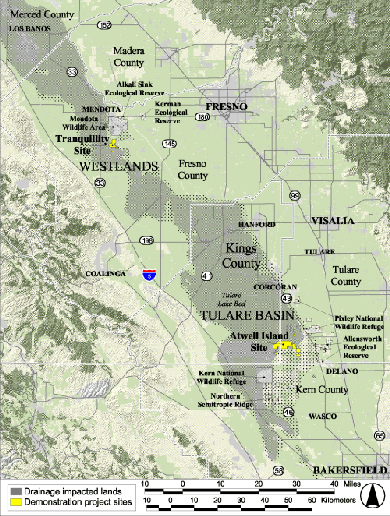|
|
Land Retirement Demonstration Project |
|
LRDP Home | Land Retirement | Habitat Restoration Study | Valley Flora Propagation Center | Restoration Research | Data and Links | ESRP Home |
|

Figure 1. Drainage impacted lands in the San Joaquin Valley.
Note: click on the image above to view a larger version.
Land Retirement Overview
The Central Valley Project (CVP), with its massive system of dams, reservoirs, canals, power plants and other facilities, began providing irrigation water for San Joaquin Valley agriculture in 1951. The San Luis Unit and the State Water Project of the CVP, which were authorized in 1960, expanded water deliveries to approximately 404,700 ha (1,000,000 acres) by 1968. By 1979, less than 61,500 ha (151,750 acres), or about 2%, remained uncultivated. The majority of the watershed was converted to agricultural production or urbanized. Most of the remaining undeveloped land is located in the foothills of the Coast Range and in the extreme southern portion of the valley. This change in land use resulted in the loss of native wetland, saltbush scrub, alkali sink, and California prairie habitats and contributed to the listing of numerous endemic species of plants and wildlife (USFWS 1998).
Extensive tracts of formerly productive farmland on the western side of the San Joaquin Valley (Figure 1) are characterized by elevated groundwater levels and high selenium. Irrigating these lands has resulted in the accumulation of poor-quality drainwater. The elimination of this drainwater is problematic and costly, and has become a point of serious environmental concern. Land retirement (i.e., the removal of land from agricultural production) is a means by which drainwater accumulation can be substantially reduced.
The FWS Biological Opinion for the LRDP raised specific concerns about the scope and degree of land retirement impacts on groundwater levels, groundwater and surface water quality, soil chemistry and biota. There was a need to monitor selenium loads at different trophic levels for corresponding groundwater levels and quality (USFWS 1999).
Additionally, the large-scale conversion of native habitat to agriculture has greatly diminished wildlife habitat in the San Joaquin Valley, thereby contributing to the endangerment of a variety of plant and wildlife species endemic to the valley. The retired agricultural lands could potentially provide wildlife habitat and contribute to the recovery of endangered and threatened plant and animal species. Hence, land retirement is a critical component of the Recovery Plan for Upland Species of the San Joaquin Valley, California ( USFWS 1998).
Retired agricultural lands can potentially provide critical connecting linkages and corridors between existing habitat areas or large areas of contiguous blocks of land. And these parcels could provide habitat for new core populations of sensitive species.
Appropriate habitat restoration must accompany land retirement to maximize benefits for wildlife and endangered species. Retiring the land without habitat restoration, or without some form of active management would likely lead to large fields infested with weeds and pests that would impact neighboring agriculture and which would require extensive and continuous management.
Although land retirement has the potential to enhance wildlife values and improve ecological systems in the San Joaquin Valley, it is also recognized that land uses other than wildlife habitat will take precedence on some lands. Some land uses, particularly grazing and, in some cases, dryland farming can be compatible with and may even contribute to habitat values for wildlife.
A multi-agency team Land Retirement Team (LRT) consisting of representatives from the the Bureau of Reclamation, the U.S. Fish and Wildlife Service, and the Bureau of Land Management was assembled to accomplish the goals of the Central Valley Project Improvement Act (CVPIA) Land Retirement Program. Concerns about the unknown physical and biotic effects of landscape-scale land retirement led to the establishment of an approximately 10,000 acre demonstration project.
In 1998 the LRT initiated a five-year Land Retirement Demonstration Project (LRDP) in cooperation with the Endangered Species Recovery Program (ESRP) in two areas on the west-side of the San Joaquin Valley. In order to generate data that would be representative of large scale land retirement, the two project sites were established in drainage-impaired basins that were geographically and physiographically distinct. The first, the Tranquillity site (Figure 1), was situated in western Fresno county site and encompassed approximately 2,200 acres. The second, the Atwell island site, was located in Kings and Tulare counties and encompassed approximately 6,800 acres.
An 800-acre habitat restoration study was established on the Tranquillity site, in order to examine restoration techniques such as microtopographic contouring and direct planting and seeding of desired native species and their potential application in native community reestablishment. Four treatments representing varying levels of expense and active management were assigned to 20 experimental plots. Biological monitoring on experimental plots began in April 1999 and concluded in December 2003. A companion study was initiated at the Atwell Island project site in 2000. ESRP conducted the baseline biological surveys and designed and installed a 480-acre Habitat Restoration Study.
REFERENCES
San Joaquin Valley Drainage Program (SJVDP). 1990a. A Management Plan for Agricultural Subsurface Drainage and Related Problems on the Westside San Joaquin Valley, Final Report of the San Joaquin Valley Drainage Program, U.S. Department of the Interior and California Resources Agency, Sacramento, CA, 183 pp.
United States Fish and Wildlife Service. 1998. Recovery plan for upland species of the San Joaquin Valley, California. Region 1, Portland, OR. 319 pp.
United States Fish and Wildlife Service. 1999. Biological Opinion formal section 7 consultation for the Central Valley Project Improvement Act Land Retirement Program Demonstration Project. Reference No. 1-1-99-0125. Sacramento, CA. 64 pp.
Page created: January 5, 2005; Last updated: July 31, 2009